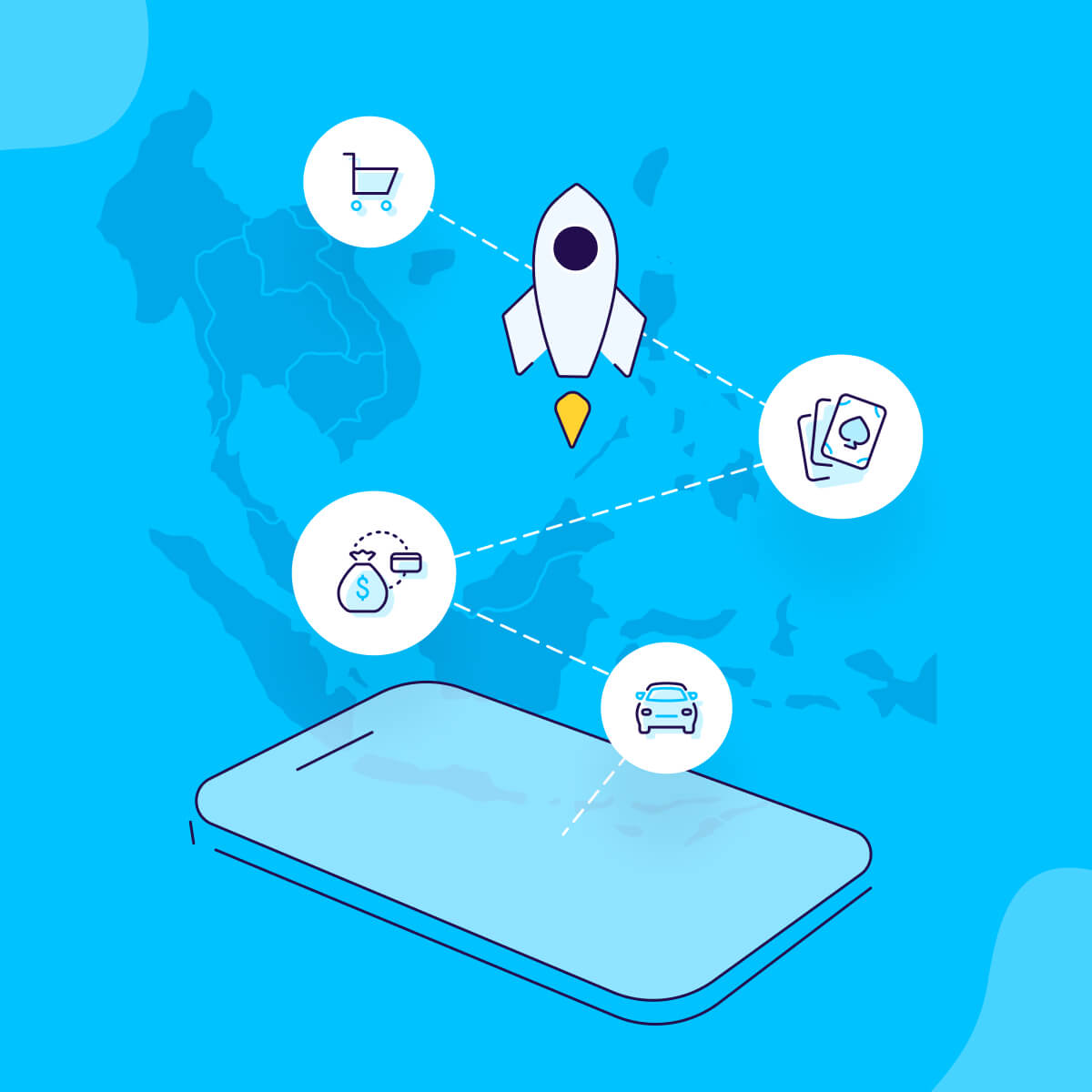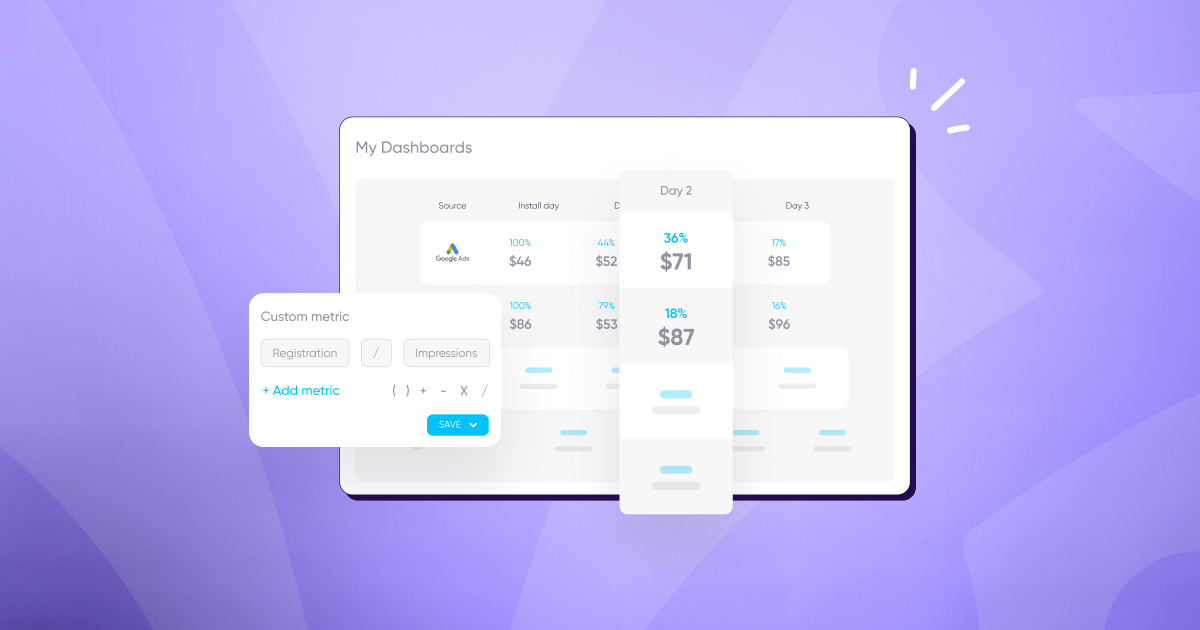
Launching your app: 11 steps to success

Users take just a few seconds to decide whether your app is worth an install. With millions of apps being launched each year, it’s not like they’re short of options.
If you want your app to stand out, you have to master the art of optimizing your mobile app launch. But the million-dollar question here is how you successfully launch your app.
There’s a lot to do—and you need to do it right.
There’s no guaranteed way to catapult your mobile app to the top of the charts, but there are certain steps you can follow to make this goal achievable.
So, buckle up as we journey through the 11 critical steps of conducting a successful mobile app launch, setting you up to attract and retain users for the long haul.
1 — Do thorough industry and competitor research
Knowing your industry and the competition’s positioning is a fundamental first step.
Why? There’s already a lot of competition, and analyzing the most popular apps will help you differentiate yours and avoid repeating common mistakes.
Identify the leading apps in your niche, and go through reviews on app pages, blogs and YouTube to get more insights on:
- What you’re facing in terms of functionality
- What users like most about these apps
- Where they fall short
- How they’re positioning themselves and where
Compare factors like pricing, feature relevance, and customer satisfaction to know what you’re up against. Be thorough in your research. The more effort you put in now, the better decisions you’ll make in the later phases of launching your app.
Remember, every competitor is fighting for your customer’s attention. The quality of your research will make the difference between a successful launch and a failed one.
2 — Understand your buyer personas

In this step, you’ll focus on your future users and what you can do to better meet their expectations.
Gone are the days when basic statements like “this app caters to executive teams” or “young people will find the app useful” would suffice. Today, you have to tell users exactly how your app will help them if you want to get their attention.
To get started, consider the following questions:
- Is your app solving a critical problem or simplifying a recurring or tedious task? If yes, what is it?
- Does your app fill a gap in your industry or improve an existing predicament?
- Why does this gap need to be filled—what problems does it lead to?
- What app features do you think will resonate most with your audience, keeping the above problems in mind?
Based on your answers, build an ideal user persona for your app to validate your product outcome and gauge how users will perceive that outcome. While you’re at it, find out what type of content, branding, and advertising platforms they like and engage with.
This will help you understand your ideal audience and provide insights to build a steady foundation for the rest of your mobile app launch.
3 — Choose your monetization model

Sort out your app’s pricing or monetization model before the launch. This is important because your pricing strategy directly affects your app’s functionality, design, and marketing strategy.
How do you choose a monetization model for your app? The right choice depends on several factors, such as competition, target market, and industry trends, but your options ultimately boil down to the following three pricing strategies:
- Free: Users can download your app from the App Store for free. You can monetize later through in-app ads and in-app purchases.
- Paid: Users will pay a fee to install your app on their devices.
- Freemium: Users can download your app for free, but they have to subscribe for a monthly or annual fee to enjoy its full functionality.
Here are a few additional questions to guide you to a more strategic pricing approach:
- How much money will it cost to keep the app running?
- How many downloads will you need, and at what price, to cover this figure?
- Compared to competitor apps, how much value does your app offer?
- How much are competitor apps charging?
Alongside pricing-focused questions, consider the features you could offer as an upsell or upgrade. If they’re enticing enough, you can opt for the freemium model.
How to ASO like a pro: App store optimization guide
4 — Define your success criteria for a successful launch
Set measurable goals and KPIs around your app launch to measure the performance of your launch campaign.
To get started, you can use KPIs like active install rate, the average rating in the app marketplace, and the total revenue generated from your app. Cost per install (CPI), retention rate, and ratio of daily/monthly active users (DAU/MAU) are other important mobile app metrics you should optimize towards.
Reviewing industry benchmarks can also help you understand what you should strive for and set realistic goals. Case in point—you’ll find several vital insights into the mobile marketing ecosystem in our 15th edition of the AppsFlyer Performance Index to better guide your app launch strategy.
5 — Choose the launch platforms for your app
Pick the right app stores or platforms to launch your app on. While Apple App Store and Google Play are the two most popular (and obvious!) options, they are not the only ones. You can consider several other app stores like GetJar and Amazon App Store.
AppsFlyer Top Tip: Do audience testing to choose the app stores most used by your target audience.
Each mobile app store has its own rules and regulations, complete with a thorough approval process. Before getting published, your app must meet and satisfy these prerequisites—otherwise, it’ll get rejected. So, learn about the rules and regulations and prepare your app to meet them.
Experts recommend choosing just one app store when you’re in the initial stage. Doing this will give you the highest possible concentration of users and ratings, helping your app rise up the ranks faster and more easily.
6 — Build a strong online presence for your app
Create awareness about your app to drum up interest by buying a domain, setting up a landing page, and creating social media accounts. These will also serve you later during the launch, making it easier for users to find and install your app.
Register your domain (for example, www.your_app_name.com) and create a landing page for your app. Mention your app’s name and description, and add a form for visitors to sign up for email alerts.
This is an excellent tactic to get leads, plus it gives you the opportunity to engage with subscribers after the launch (with their permission, of course).
Think of it as a cost-effective marketing channel to advertise your app both before and after the launch.
Next, you’ll create a presence on popular social media platforms.
The best social networks for your app depend on your target audience. For example, if your targeting criteria are age-specific, pick networks most popular with that specific age bracket: the younger crowd is likely to be on Instagram, while Facebook is often the preferred social network for middle-aged users.
Alongside claiming social media accounts, use other methods to spread awareness and reach your target audience. We recommend creating business pages and pop-up ads and starting advertising campaigns to build a group of interested people before the launch.
7 — Plan a beta or soft launch and collect reviews
People want to know whether your app can bring genuine value to their lives. Getting early reviews and testimonials serves as social proof, encouraging them to give your app a shot.
And the easiest way to get these reviews? Beta testing.
The beta is the near-final version of your app, available only to a select few testers of your choice. It tells you how the app works in the “real world,” making it easier to iron out last-minute issues and providing users with a relatively bug-free experience after release.
Use this opportunity to crowdsource quality assurance and test if every functionality is in place. For starters, you can check if the UI design is clear, if users can easily navigate and interact with the app, and how much time they need to get to the conversion.
Both Apple and Google encourage app creators to plan beta tests and have created the following step-by-step guides for the whole process:
The key to beta testing success is gathering the right group of testers and aiming for quality over quantity. The closer you get to the target group, the more insights you’ll discover to polish your app. And you don’t need a huge number of testers for this—just a few relevant ones are enough to get the job done.
8 — Create and optimize App Store assets
App Store assets include screenshots, app previews, images, app promo videos, and routing app coverage files, among several other formats, designed to tell your app’s story.
Potential users view App Store assets to learn what your app can do and decide if it’s worth installing. You can also use these assets in your other marketing endeavors, such as social media and landing page content, helping arouse interest and boost conversions.
Besides visual assets, you need to lock in your app’s messaging and description, ensuring the language used resonates with your targeted users.
This is also where app store optimization (ASO) comes into the picture.
ASO is a marketing method aimed at improving your app’s visibility and appeal on app marketplaces like App Store and Google Play. Similar to search engine optimization (SEO), ASO uses keyboards and quality images to help your app rank higher in the App Store.
Why pay attention to ASO?
Glad you asked.
Smartphone users typically rely on app stores to discover new apps. When you optimize your listing page by adding terms they’re likely to use when describing your app, your app becomes more visible in the App Store.
The fact that ASO is also a cost-effective way to increase conversion rates is another advantage.
Both iOS App Store and Google Play Store use similar ranking variables, so you won’t have to put in extra work when launching your app on another platform.
AppsFlyer Top Tip: Placing keywords within the app name positively impacts search rankings, but this may not always be possible. In this case, simply use your brand name, followed by a keyword-focused description. For example, “Uber – Request a ride” and “DoorDash – Food Delivery.”
9 — Create a strong app launch strategy

Having a strong app launch strategy plays a crucial role in making your app more successful. The main aim here is to promote your app to create greater engagement through owned, earned, and paid media.
- Owned media: This includes platforms you own and control—for example, your website or landing page.
- Earned media: This involves a third party publishing information about your app and company brand. Examples include reviews on Google and Yelp or blog posts discussing your app’s features.
- Paid media: This is where you pay a fee to reach an audience. Examples include hiring an influencer to spread awareness about your app or putting up display ads and commercials.
Create relevant content that clearly explains how to use your mobile app. This can include blog posts, social media content, website copy, email marketing copy, and press releases. You should also have a press kit to hand when reaching out to journalists and bloggers to get them to promote your app on their respective platforms.
Press kits usually contain the following:
- App graphics and creatives
- A brief description of your app
- Links to your website and social media accounts
- Contact information
Once you’ve paved the way to build engagement organically, you should set up paid targeted ads on popular online platforms like Facebook and Instagram.
These ads may take visitors to your website to sign up for your mobile app or, after you’ve launched the app, straight to the app downloads page so they can install it on their phones.
Although you don’t have to use all three media types (owned, earned and paid), this triple-pronged approach is useful in building a strong online presence for your app. It’ll help you generate more app awareness and ultimately drive higher revenue.
10 — Identify and integrate with the necessary software to measure success
The final step before the big launch is integrating any analytics tool and software with your existing system, so you can track your mobile app launch against your previously identified success criteria.
Register with a push provider and implement any other software you may need to effectively market, grow, and maintain your app post-launch. Also, don’t forget to add in-app feedback software to your tech stack to collect high-quality customer feedback and inform your product roadmap.
11 — Launch time! Submit your app to the app stores
It’s finally time to roll your app out to the users!
Publish your app on your chosen app stores, ensuring you’re meeting all applicable guidelines. To stay on the safe side, you can post your app a few weeks before the official release.
Once the app stores give your app the green light, it’s time to notify your email subscribers, press list, and influencers about its release. You can also offer promo codes, special deals, and other incentives to thank your subscribers for their loyalty and attention.
Next, you’ll focus your energy on monitoring feedback and app store ranking.
Encourage users to leave reviews to help you identify and fix bugs faster, as well as gather feedback and measure satisfaction. You can also offer a discount or an account upgrade to further entice them.
App ratings can make or break your product. Focus on improving ranking factors that help you maximize exposure and score a rating higher than four stars to ensure your app stays for the long haul.
Key takeaways

- Through careful competitor and industry research, you can identify effective ways to make your mobile app stand out and avoid costly mistakes. The insights you’ll gather also enable better decision-making post-launch.
- Your pricing strategy should be based on your app’s competition, target audience, and industry trends. Choose between free, paid, and freemium monetization models.
- Every app store has its own set of rules and regulations. As an app creator, it’s your job to be aware of these and make sure your app complies. .
- Beta testing is the most effective way to collect user reviews and testimonials that encourage other users to give your app a shot early in the launch process. It also helps you identify and iron out issues and remove bugs, enabling you to deliver a positive app experience to end users.
- App store assets like screenshots, promo videos, and reviews help arouse user interest and boost conversions. Creating content following app store optimization (ASO) best practices is also useful to get your app to rank higher in the app stores.
- An effective mobile app launch strategy uses a combination of owned media (platforms you own and control), earned media (information published by third parties), and paid media (paid ads) to bolster your app marketing efforts.
- Getting app reviews and ratings is important so you can gather feedback and measure user satisfaction. You can offer users special deals and promo codes to encourage them to submit a rating or feedback.




